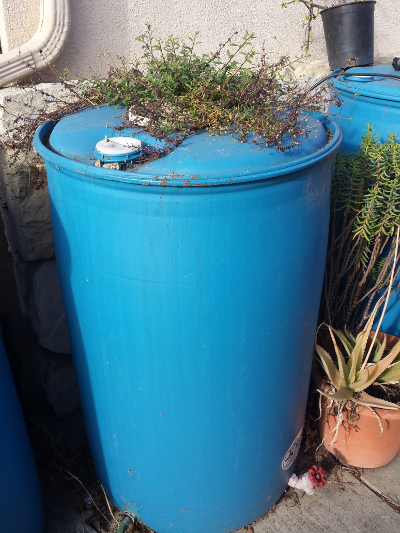
Why Try a Rain Barrel, even if it is so small
Rain barrels raise awareness
When we use hose water, we’re barely aware of the waste. It’s too easy to drop the hose to answer the phone (that’s why L.A. Drought-buster guidelines require shut-off valves on hoses), too easy to direct the water to non-essential purposes like hosing off the patio chairs.
When we haul water we begin to think differently. We start to notice where every single drop goes, because we had to save it and haul it in order to use it.
Rain barrels are a terrific low-tech simple tool to get people thinking about water in a radical, root level, different way. I’ve had rain barrel newbies come to me and exclaim how quickly the barrel fills in a single storm (i.e. within minutes). Then they come back to express their amazement and dismay at how far the water didn’t go as they used it, thus how they began using it so much more carefully.
Rain barrels are an excellent way to “dip your toe in the water” of beginning rainwater awareness.
Rain barrels capture sweet rain
Have you ever noticed how much better your plants grow after a rain — far better than with hose water?
Here in Los Angeles, much of our irrigation water is alkaline. Rain water isn’t salty and isn’t alkaline. I heard somewhere that rain captures nitrogen from the atmosphere. By saving rain for later use, you’ve extended the “rainy season” so that your plants get just a bit more of the really good stuff.
Ever notice that white crusty junk around the edges of the soil of your potted plants? That’s accumulated salts, and rainwater won’t do that. I use saved rainwater primarily to give a great growth boost to my seedling starts and container plants. Your plants will reward you for it.
Rain awareness
Our encultured habit is to look out the window on a winter’s day and whine “awww, it’s raining.” When you have rain barrels you to shift to an excited “YEAH! It’s raining!” (followed by a sprint outdoors to watch the water pour into your tanks).
Rain barrels are yet another way to connect us to the seasons of life, the great outdoors, the natural world around us, in ways that — cooped up in climate-controlled buildings — we’ve forgotten how.
Rain barrels are not meant to replace 100% of your water meter use. They’re not even meant to save up enough water to sustain your entire garden. (To do that, you’d need multiple rain tanks, which are far bigger than barrels, but more likely a cistern.)
The wise way to use rain barrels is to use up the contents between the storms, so that the same container storage capacity is available again for the next storm. Thus you begin watching the weather, and racing the rain. It’s a new, future-oriented kind of game.
Emergency preparedness
Here in earthquake country, rain barrels can be another part of the panorama of backup water storage. Photos of Japanese cities after their big earthquake remind us that even in a highly sophisticated country, after an emergency people desperately need water.
Yes, there is the toilet tank, and the hot water tank, and the drinking water you stored if you followed the fire department recommendations. No, you cannot drink rain barrel water without specialized filtration, but you and your neighbors will need water for fires and washing and other uses too.
Note that rain barrels full of water are VERY heavy. In order to survive even a mild quake, you need to settle the empty tank on a solid base or foundation where it won’t tip or “walk” during the shaker.
Reduce first, then go green
Get wise first: unhook from the opulent consumption lifestyle (which our planet can no longer afford anyhow).
I tell people this with respect to solar panels: power-down your habits and your lifestyle first, then only buy solar for the remainder. You’ll save a lot of money!
With respect to rain barrels, change to water efficient habits, hydrozones, swales/berms, deep mulch, climate-appropriate food plants, first. Then add barrels (mine are made from repurposed food container barrels) for those special remaining needs.
Use a combination of approaches
I say it in my organic gardening classes with respect to pest control, and it applies to water wisdom, too: A single-pronged approach won’t do it.
You need to attack the problem from all sides. Reduce your consumption. Increase your awareness. Use berms/swales/mulch. Use infiltration as well as storage techniques. Build healthy soil. Change your plant palette. Bucket in the shower. Greywater-plumb your laundry (and consider guerilla greywater too). Use found materials as shade devices. And use rain barrels. Do all of the above in combination, to move your gardening into the future.
You might also like:

